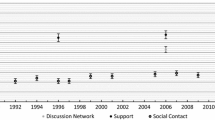Abstract
Two questionnaire studies in rural Georgia examined how social and spatial density were related to social burden and social support. Results from the first study, which had 116 female respondents (82% white, 16% black, 2% Hispanic), indicated that high social density of males was related to less liking of the house and more psychological distress. Based on Study 1, it was hypothesized that high social density of males was related to less received social support whereas social density of females was related to more received social support. In partial support of that hypothesis, results from the second study, which involved 94 males and 105 females (83% white, 17% black), revealed that received emotional support was positively correlated with social density of females in the household. Also, consistent with Study 1, females considered males to be more burdensome than females. In addition, results from Study 2 suggested that males and females respond differently to social density.
Similar content being viewed by others
References
Aiello, J. R., Baum, A., & Gormley, F. P. (1981). Social determinants of residential crowding stress.Personality and Social Psychology Bulletin, 7 643–649.
Akioka, L. M. (1988–1989).Georgia statistical abstract. Athens, GA: University of Georgia Press.
Baron, R. M., & Kenny, D. A. (1986). The moderator-mediator variable distinction in social psychological research: Conceptual, strategic, and statistical considerations.Journal of Personality and Social Psychology, 51 1173–1182.
Barrera, M., Jr. (1988). Models of social support and life stress: Beyond the buffering hypothesis. In L. H. Cohen (Ed.),Life events and psychological functioning. (pp. 211–236). Newbury Park, CA: Sage.
Barrera, M., Sandler, I. N., & Ramsay, T. B. (1981). Preliminary development of a scale of social support: Studies on college students.American Journal of Community Psychology, 9 435–447.
Baum, A., & Valins, S. (1977).Architecture and social behavior: Psychological studies of social density. Hillsdale, NJ: Erlbaum.
Bell, R. R. (1981).Worlds of friendship. Beverly Hills, CA: Sage.
Bureau of the Census. (1983).1980 census of population: General social and economic characteristics (PC80-1-C-12). Washington, DC: U.S. Department of Commerce.
Evans, G. W., Palsane, M. N., Lepore, S. J., & Martin, J. (1989). Residential density and psychological health: The mediating effects of social support.Journal of Personality and Social Psychology, 57 994–999.
Gove, W. R., & Hughes, M. (1983).Overcrowding in the household: An analysis of determinants and effects. New York: Academic Press.
Kessler, R. C., & McLeod, J. D. (1985). Social support and psychological distress in community surveys. In S. Cohen & S. L. Syme (Eds.),Social support and health. (pp. 19–40). New York: Academic Press.
Lakey, B. (1989). Personal and environmental antecedents of perceived social support developed at college.American Journal of Community Psychology, 17 503–519.
Lepore, S. J., Evans, G. W., & Schneider, M. L. (1991). Dynamic role of social support in the link between chronic stress and psychological distress.Journal of Personality and Social Psychology, 61 899–909.
Office of Planning and Budget. (1989).Georgia descriptions in data. Atlanta: State of Georgia.
Paulus, P. B. (1988).Prison crowding: A psychological perspective. New York: Springer-Verlag.
Pennebaker, J. W., Burnam, M. A., Schaeffer, M. A., & Harper, D. C. (1977). Lack of control as a determinant of perceived physical symptoms.Journal of Personality and Social Psychology, 35 167–174.
Rook, K. S. (1984). The negative side of social interactions: Impact on psychological well-being.Journal of Personality and Social Psychology, 46 1097–1108.
Ross, M., Layton, B., Erickson, B., & Schopler, J. (1973). Affect, facial regard, and reactions to crowding.Journal of Personality and Social Psychology, 28 69–76.
Ruback, R. B., & Carr, T. S. (1984). Crowding in a women's prison: Attitudinal and behavioral effects.Journal of Applied Social Psychology, 14 57–68.
Ruback, R. B., Carr, T. S., & Hopper, C. S. (1986). Perceived control in prison: Its relation to reported crowding, stress, and symptoms.Journal of Applied Social Psychology, 16 375–386.
Ruback, R. B., & Pandey, J. (1991). Crowding, perceived control, and relative power: An analysis of households in India.Journal of Applied Social Psychology, 21 315–344.
Stokols, D., Rall, M., Pinner, B., & Schopler, J. (1973). Physical, social, and personal determinants of the perception of crowding.Environment and Behavior, 5 87–117.
Vaux, A. (1988).Social support: Theory, research, and intervention. New York: Praeger.
Wheeler, L. (1988). My year in Hong Kong: Some observations about social behavior.Personality and Social Psychology Bulletin, 14 410–420.
Author information
Authors and Affiliations
Rights and permissions
About this article
Cite this article
Ruback, R.B., Riad, J.K. The more (men), the less merry: Social density, social burden, and social support. Sex Roles 30, 743–763 (1994). https://doi.org/10.1007/BF01544229
Issue Date:
DOI: https://doi.org/10.1007/BF01544229



